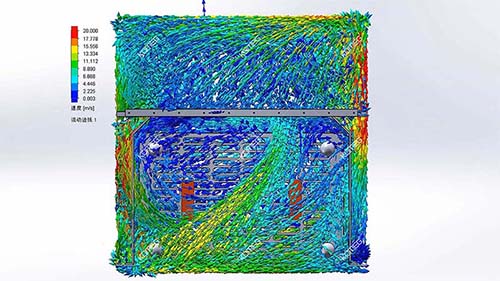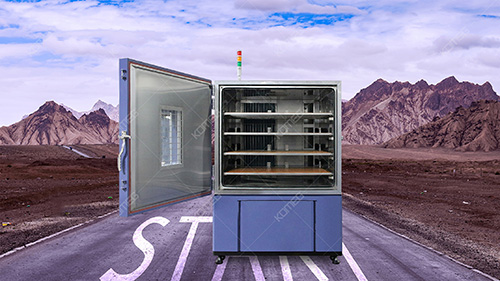How to deal with the problem of uneven temperature in the environmental test chamber
First, let's look at the reasons for the uneven temperature of the constant temperature and humidity chamber:
1. Impact of test objectives
If enough test samples are placed in the chamber of the constant temperature and humidity chamber to affect the overall internal heat convection, the uniformity of the internal temperature, that is, the temperature uniformity, will be affected to a certain extent. For example, if LED lighting products are placed, the product itself will emit light and heat, which will become a thermal load, then the temperature uniformity will be greatly affected.
2. Thermal insulation materials
The thermal insulation material is the key point to ensure the uniformity of the constant temperature and humidity chamber. If the manufacturer of the constant temperature and humidity chamber does not handle the thermal insulation material well, it will directly lead to excessive uniformity deviation in the chamber. Generally, we choose polyurethane insulation+glass fiber.
3. Air circulation system
The uniformity of the constant temperature and humidity chamber is improved through air circulation. There is an air conditioning duct behind the test area. After the heating pipe heats the air, it drives a stainless steel multi wing centrifugal wind wheel through a high temperature resistant long shaft motor. After uniform mixing, it passes through an adjustable louver outlet to achieve uniform temperature.
4. Difference in internal structure of test chamber
For example, it is sometimes difficult to reach a uniform symmetrical structure in the internal structure and space planning of the constant temperature and humidity chamber, which will affect the indoor thermal convection and cause errors in the internal temperature uniformity.
This level is mainly reflected in the influence of sheet metal planning and sheet metal processing, such as the planning of air duct, the placement position of the heating pipe of the constant temperature and humidity chamber manufacturer, and the fan power. These details will affect the temperature uniformity in the chamber.
5. Difference of heat transfer coefficient of inner wall of test chamber
Due to the different heat transfer coefficients of the front, back, left, right, upper and lower six surfaces of the chamber wall of the studio, some of them have threading holes, inspection holes, test holes, etc., which lead to local heat dissipation and heat transfer, making the chamber temperature uneven, thus making the chamber wall radiative convection heat transfer uneven, affecting the temperature uniformity.
6. Air convection in the chamber
During the test, if the volume of the test object is too large, or the test object is placed in the working chamber of the high and low temperature damp heat test chamber in an inappropriate position or manner, the air convection in the chamber will be blocked, and large temperature uniformity deviation will also occur. For example, placing the test product next to the air duct will not only seriously affect the wind circulation, but also greatly affect the temperature uniformity.
It is generally required that the area of the test article in the section shall not be greater than 1/3, and each product shall not be placed densely to ensure convection between the surrounding air and the air in the middle.
The sample shall not block the air outlet, and shall be at a certain distance from the air outlet. The test object shall not be placed around the air duct, which will seriously affect the wind circulation. The test sample shall be placed stably to ensure that the wind wheel is placed evenly and the air outlet is uniform.
7. Tightness of chamber
If the sealing strip is not customized and has joints, or if the door of the constant temperature and humidity chamber leaks, it will greatly affect the temperature uniformity in the test chamber. Therefore, there are quite strict requirements for the sealing strip of the test chamber, and it must have the characteristics of high temperature and low temperature resistance.

So, what can be done to improve the temperature uniformity of the test chamber?
1. Pay attention to the tightness of the chamber to prevent local air leakage. Select thermal insulation materials with excellent performance. Sufficient insulation layer thickness can reduce heat loss; The connecting pieces between the tank and the shell shall be provided with thermal isolation measures to reduce local heat leakage.
2. Pay attention to the volume and weight of the test object and the placement position in the working space of the test chamber. According to relevant standards, the total volume of the test object is less than 1/5 of the working room, so as to leave enough ventilation space. The area of the test object on each windward surface should be less than 1/3 of the windward sectional area, so as to facilitate the flow of wind. These regulations play a good role in ensuring that the temperature in the chamber is uniform and the temperature deviation does not exceed the standard requirements.
3. Reduce the air supply temperature difference and increase the air supply volume. Reducing the temperature difference of air supply can reduce the impact of air flow on the temperature field in the studio, and can protect the temperature difference more effectively. Increasing the air supply volume can not only reduce the air supply temperature difference, but also ensure the elimination of indoor air flow dead zone.
4. Increase the wind speed under the conditions allowed by the test method to enhance the air flow in the chamber, eliminate the dead zone, and make the temperature in the chamber uniform.
5. Improve the control accuracy of the constant temperature and humidity chamber and reduce the temperature fluctuation, thus reducing the temperature deviation.
For the temperature rise process of the test chamber, PID continuous adjustment of the heating power can reduce the temperature fluctuation; For the cooling process of the test chamber, in order to reduce the temperature fluctuation, the heat balance method is usually used to control the temperature, that is, after reaching the set temperature, the refrigerator is still on, and the controlled heating power is used to balance the excess cooling capacity.
In order to avoid wasting too much energy due to excessive cold and hot shock, the measures of regulating the cooling capacity are often adopted to reduce the cooling capacity at constant temperature, so that the heating capacity required for balance will be reduced, which not only saves energy, but also improves the control accuracy.
The position of the temperature sensor has a great influence on the control accuracy. In order to make its temperature sensing response sensitive, the sensor is generally placed near the air outlet to improve the control accuracy, reduce the temperature fluctuation and finally reduce the temperature deviation.
6. Adjust the set value of the temperature field to reduce the temperature deviation. The upper and lower temperature deviations are often not equal. If the upper or lower temperature deviations exceed the allowable deviation, but one half of the difference between the upper and lower deviations is still less than the allowable deviation, the temperature setting value of the equipment can be properly adjusted to make the adjusted temperature deviation less than the allowable deviation.
As the "originator" of the above points that affect the temperature uniformity in the temperature and humidity test chamber, we hope that you can solve your problems one by one when problems occur.











